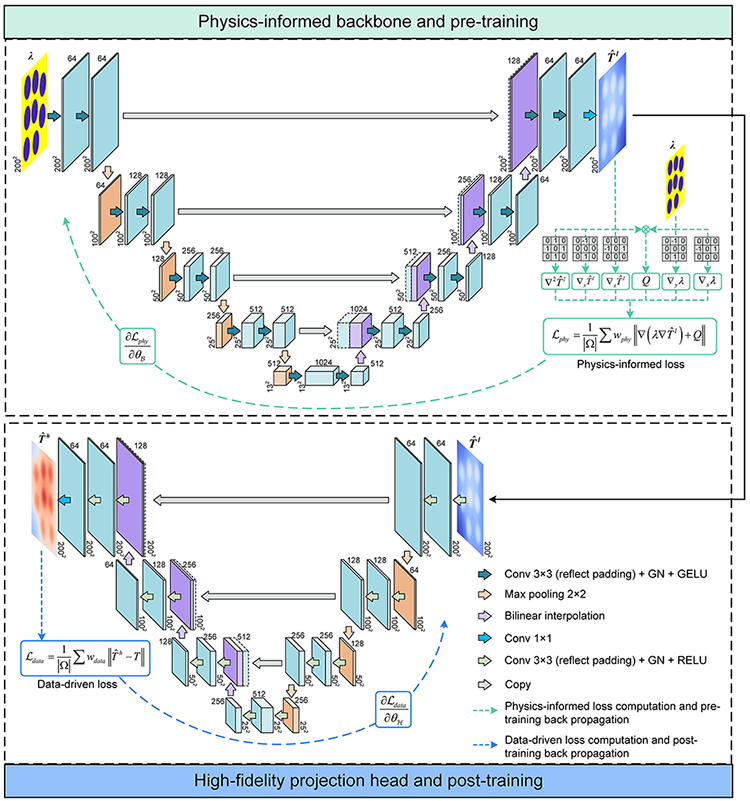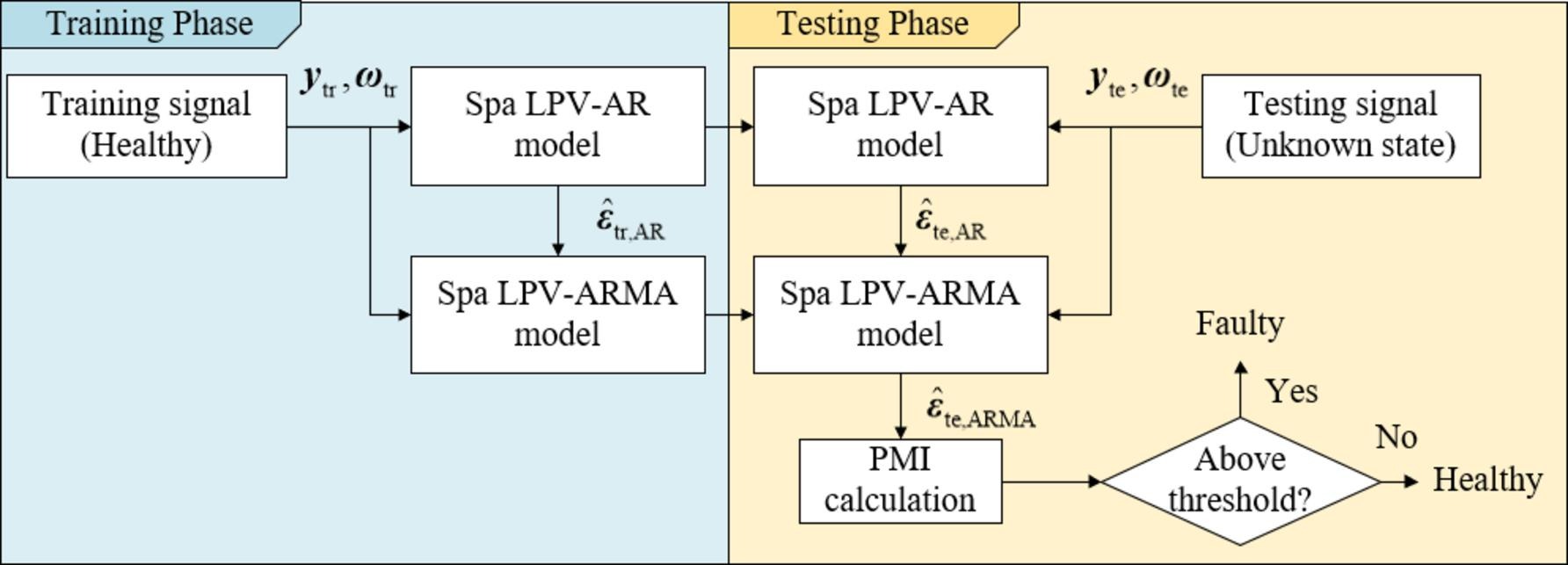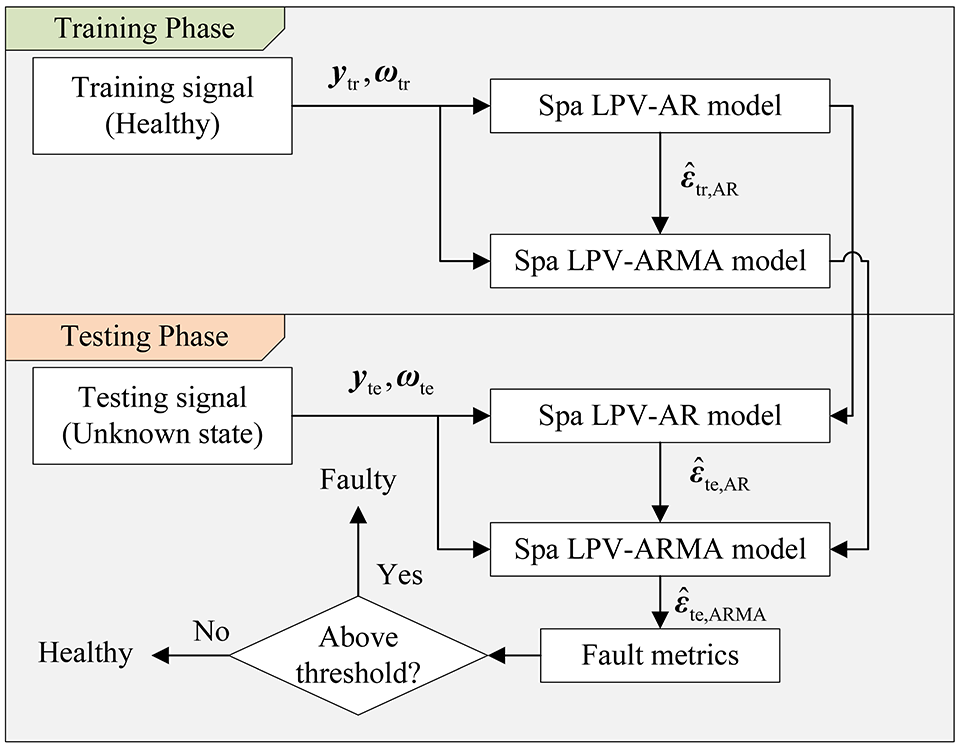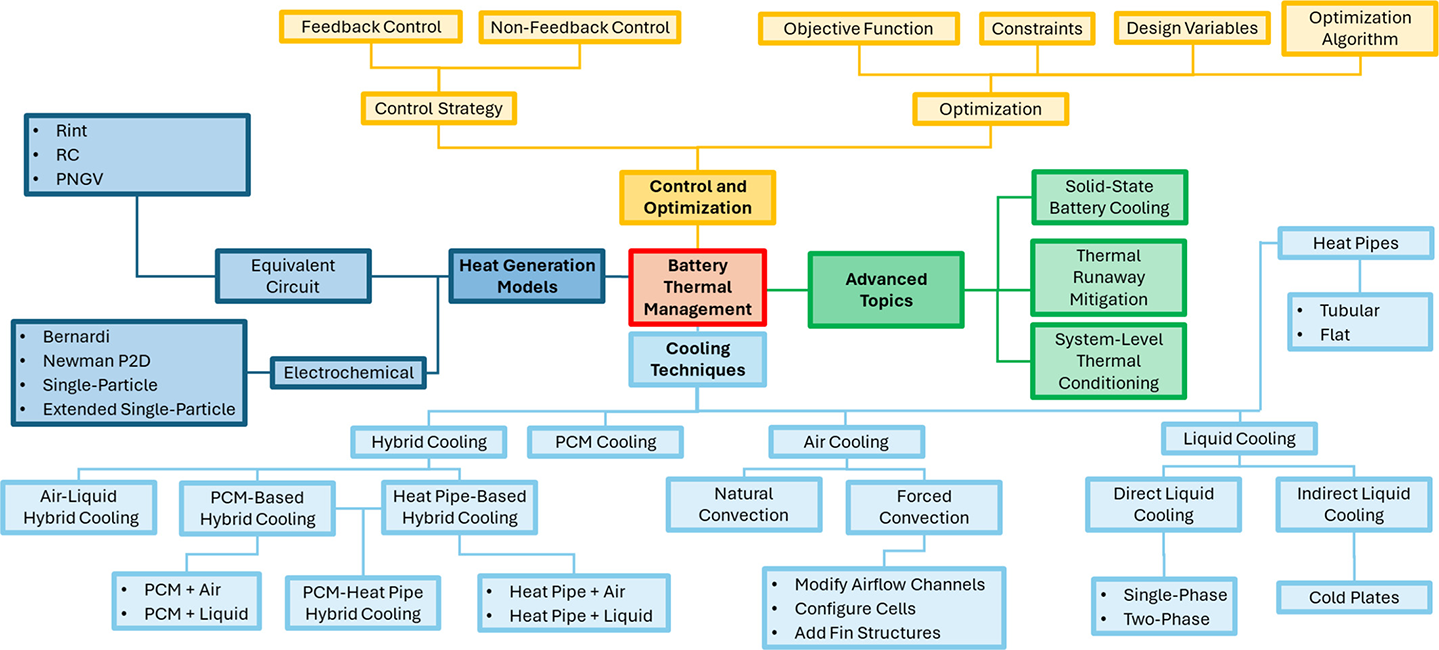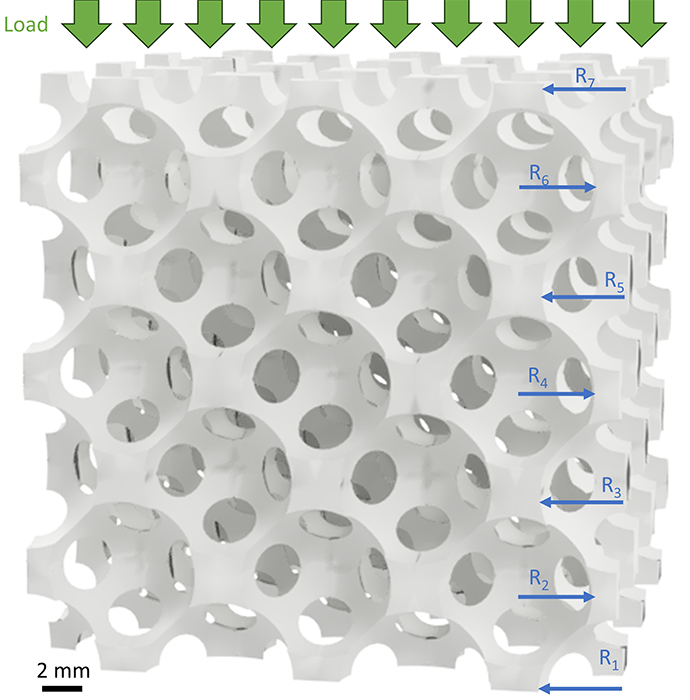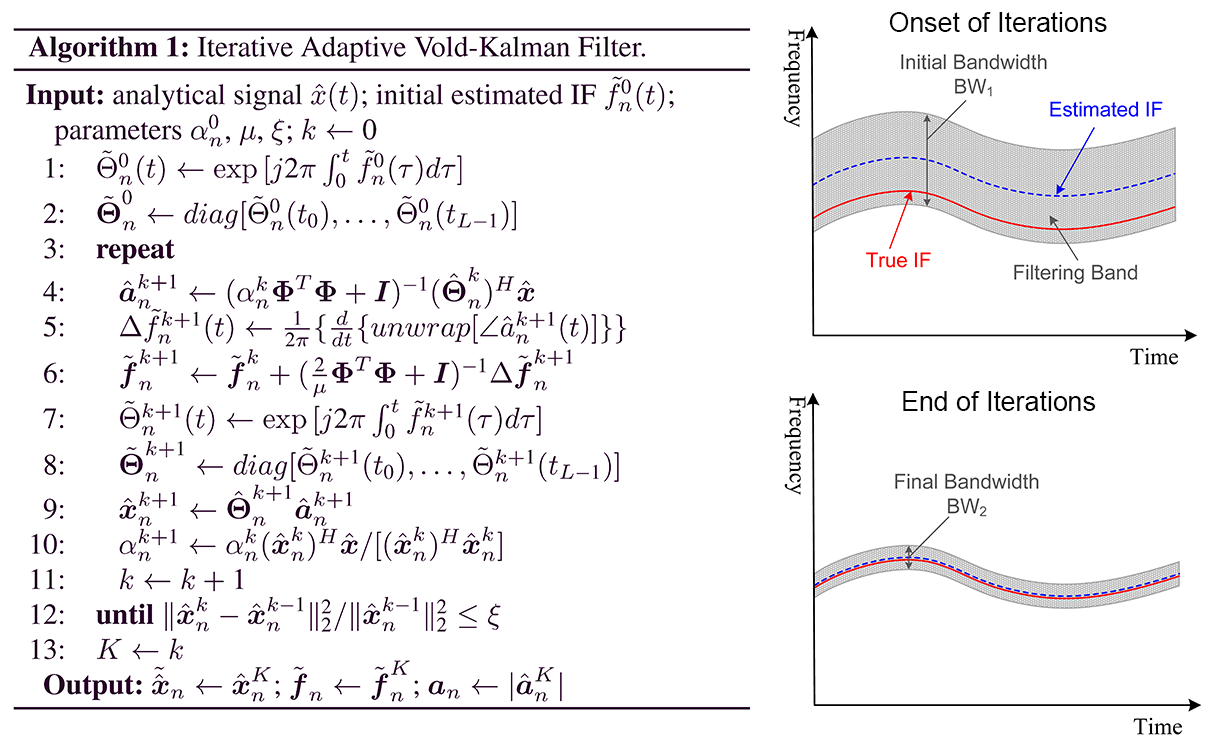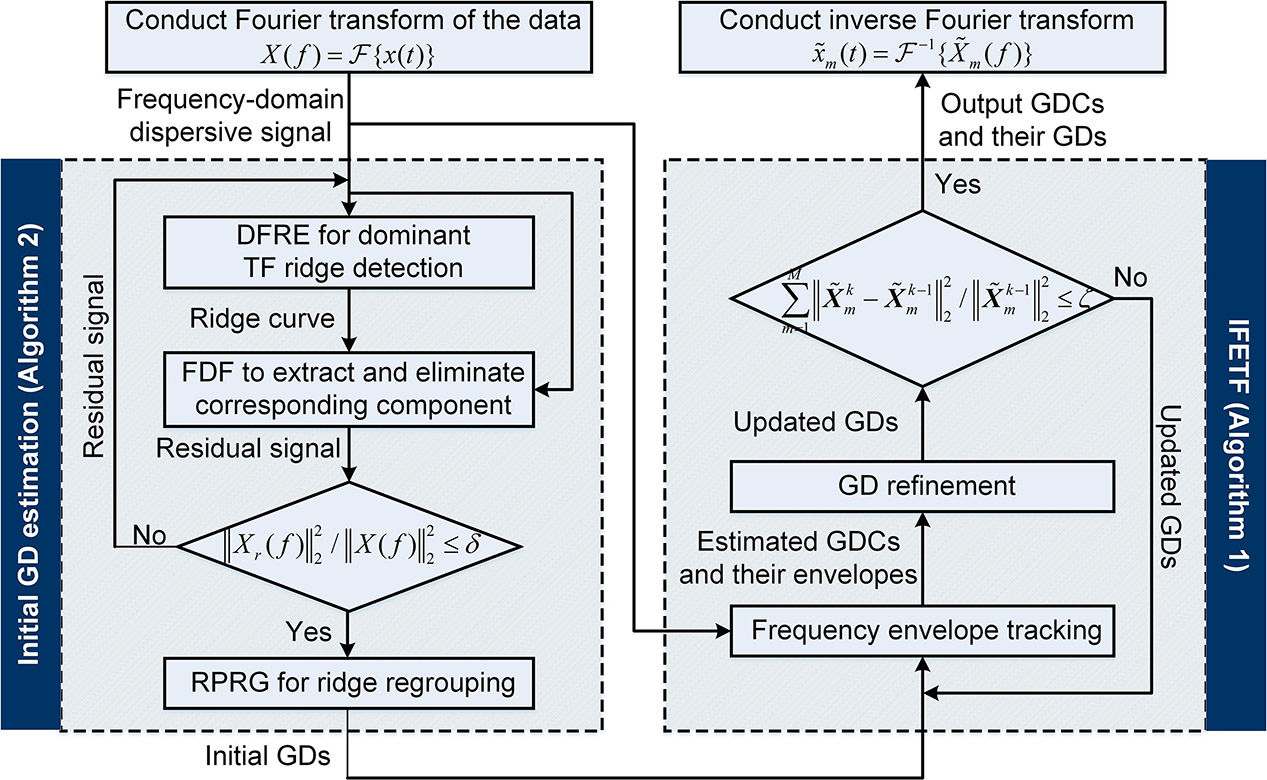Publications
Categorized in reverse chronological order.
2025
- Multi-fidelity physics-informed convolutional neural network for heat map prediction of battery packsYuan Jiang#, Zheng Liu#, Pouya Kabirzadeh, Yulun Wu, Yumeng Li, Nenad Miljkovic, and Pingfeng WangReliability Engineering & System Safety, 2025
The layout of battery cells in liquid-based battery thermal management systems determines the temperature distribution within a battery pack, which, in turn, affects the safety, reliability, and efficiency of the battery system. Therefore, real-time heat map prediction is of great importance for battery design optimization and control strategy refinement. However, the scarcity of high-fidelity data as well as the imperfections of low-fidelity physics knowledge significantly hinder the accuracy of both data-driven and physic-informed machine learning (PIML) surrogate models. To tackle these challenges, this paper proposes a novel multi-fidelity physics-informed convolutional neural network (MFPI-CNN) that integrates low-fidelity domain-specific knowledge with limited high-fidelity data to provide accurate and trustworthy real-time battery heat map estimations. First, to facilitate the integration of heat transfer knowledge into machine learning models, a complex three-dimensional battery heat transfer problem is simplified to an equivalent two-dimensional representation as low-fidelity physics knowledge. Then, the MFPI-CNN with a physics-informed backbone and a high-fidelity projection head is proposed to generate battery heat maps at various fidelity levels. The backbone’s pre-training employs an unsupervised PIML framework, embedding heat transfer partial differential equations and boundary conditions within the loss function and padding modes. The high-fidelity projection head with a simplified structure is then appended to the fixed backbone and trained by limited labeled data. Both the backbone and projection head are equipped with appropriate modules and linear-weighting loss functions to normalize convergence speed. The efficacy of the model simplification is verified by various battery experiments and simulations. Comparative results and ablation studies on heat map predictions demonstrate that the proposed MFPI-CNN outperforms traditional data-driven, physics-informed, and other multi-fidelity surrogate models.
@article{jiang2025multi, title = {Multi-fidelity physics-informed convolutional neural network for heat map prediction of battery packs}, author = {Jiang#, Yuan and Liu#, Zheng and Kabirzadeh, Pouya and Wu, Yulun and Li, Yumeng and Miljkovic, Nenad and Wang, Pingfeng}, journal = {Reliability Engineering \& System Safety}, volume = {256}, pages = {110752}, year = {2025}, publisher = {Elsevier}, doi = {10.1016/j.ress.2024.110752}, } - RAMS
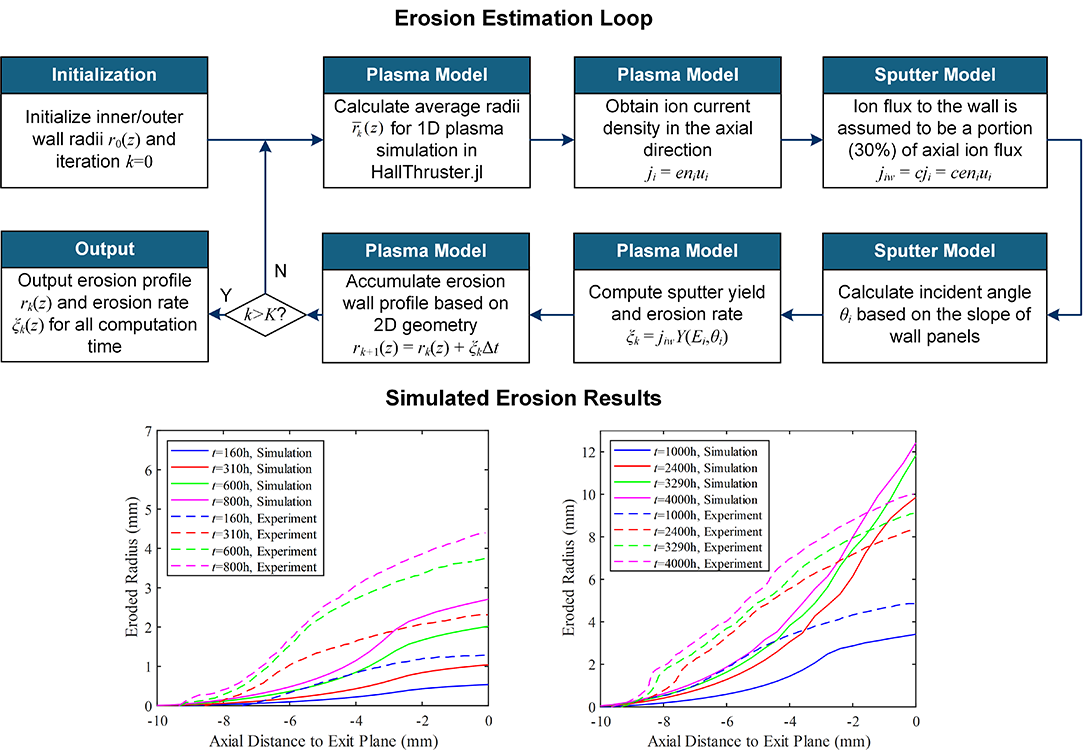 Prognostics of Hall thruster erosion using multiphysics-based modeling and machine learningYuan Jiang, Alexandra N Leeming, Joshua L Rovey, and Pingfeng WangIn 2025 Annual Reliability and Maintainability Symposium (RAMS), 2025
Prognostics of Hall thruster erosion using multiphysics-based modeling and machine learningYuan Jiang, Alexandra N Leeming, Joshua L Rovey, and Pingfeng WangIn 2025 Annual Reliability and Maintainability Symposium (RAMS), 2025Hall thrusters, a type of propulsion device with high specific impulses, have gathered substantial interest within the aerospace community. However, the challenge of thruster wall erosion induced by sputtering impedes their stable and reliable function. This paper proposes a novel prognostic framework for estimating Hall thruster channel wall erosion based on multiphysics simulation and machine learning. First, a one-dimensional (1D) plasma discharge code is introduced to simulate plasma dynamics within discharge channel. Then, the erosion rate is quantified based on a semi-empirical sputter yield model. In addition, an erosion profile estimation loop is proposed to accommodate the 1D simulation while leveraging 2D erosion profiles. Finally, a machine-learning polynomial regression model serves as a surrogate model, facilitating efficient erosion rate estimations without extensive computations. Results and comparisons demonstrate that the proposed low-fidelity prognostic framework reliably reflects the erosion trends observed in high-fidelity models and experimental data, while reducing both simulation and testing requirements.
@inproceedings{jiang2025prognostics, title = {Prognostics of Hall thruster erosion using multiphysics-based modeling and machine learning}, author = {Jiang, Yuan and Leeming, Alexandra N and Rovey, Joshua L and Wang, Pingfeng}, booktitle = {2025 Annual Reliability and Maintainability Symposium (RAMS)}, pages = {1--7}, year = {2025}, organization = {IEEE}, doi = {10.1109/RAMS48127.2025.10935282}, } - RAMSPhysics-informed machine learning for battery pack thermal managementZheng Liu#, Yuan Jiang#, Yumeng Li, and Pingfeng WangIn 2025 Annual Reliability and Maintainability Symposium (RAMS), 2025
With the popularity of electric vehicles, the demand for lithium-ion batteries is increasing. Temperature significantly influences batteries’ performance and safety. Battery thermal management systems can effectively control the temperature of batteries; therefore, batteries’ performance and safety can be ensured. However, the development process of battery thermal management systems is time-consuming and costly due to the extensive training dataset needed by data-driven models requiring enormous computational costs for finite element analysis. Therefore, a new approach to constructing surrogate models is needed in the era of AI. Physics-informed machine learning enforces the physical laws in surrogate models, making it the perfect candidate for estimating battery pack temperature distribution. In this study, we first developed a 21700 battery pack indirect liquid cooling system with cold plates on the top and bottom with thermal paste surrounding the battery cells. Then, the simplified finite element model was built based on experiment results. Due to the high coolant flow rate, the cold plates can be considered as constant temperature boundaries, while battery cells are the heat sources. The physics-informed convolutional neural network served as a surrogate model to estimate the temperature distribution of the battery pack. The loss function was constructed considering the heat conduction equation based on the finite difference method. The physics-informed loss function helped the convergence of the training process with less data. As a result, the physics-informed convolutional neural network showed more than 15% improvement in accuracy compared to the data-driven method with the same training data.
@inproceedings{liu2025physics, title = {Physics-informed machine learning for battery pack thermal management}, author = {Liu#, Zheng and Jiang#, Yuan and Li, Yumeng and Wang, Pingfeng}, booktitle = {2025 Annual Reliability and Maintainability Symposium (RAMS)}, pages = {1--7}, year = {2025}, organization = {IEEE}, doi = {10.1109/RAMS48127.2025.10935157}, } - RAMSTransductive transfer learning features for prognostics and health managementShimeng Yang, Yuan Jiang, Zheng Liu, and Pingfeng WangIn 2025 Annual Reliability and Maintainability Symposium (RAMS), 2025
This paper presents a comparison study of multiple feature extractors adapted from popular deep learning models for Prognostics and Health Management (PHM) in predicting remaining useful lives (RULs). The study focuses on the ability of these feature extractors in developing a domain- adversarial neural network to solve the domain shift problem in predicting RULs on unlabeled new datasets. The feature extractors are trained on the same labeled dataset and the extracted features are then fed into a benchmark regression model to predict the RUL values, therefore analyzing their applicability and effectiveness in transfer learning for PHM applications. The training and the evaluation studies have also been performed on the NASA turbofan engine degradation simulation dataset, which has four subsets each with different operating condition settings and failure modes thus having different marginal distribution of data. The evaluation phase consists of two experiments. In the first experiment, the accuracy of models with different feature extractors is evaluated by comparing the root mean square error values of the predicted RUL across various test subsets. The second experiment includes predicting the entire sequence of RULs of one engine until failure. These two case studies provide valuable insights about how different models handle varying degrees of domain shifts and their potential for accurate and reliable predictions in practical PHM applications.
@inproceedings{yang2025transductive, title = {Transductive transfer learning features for prognostics and health management}, author = {Yang, Shimeng and Jiang, Yuan and Liu, Zheng and Wang, Pingfeng}, booktitle = {2025 Annual Reliability and Maintainability Symposium (RAMS)}, pages = {1--7}, year = {2025}, organization = {IEEE}, doi = {10.1109/RAMS48127.2025.10935143}, } - ITECPhysics-informed machine learning enhanced battery pack optimizationZheng Liu#, Yuan Jiang#, Yumeng Li, and Pingfeng WangIn 2025 IEEE/AIAA Transportation Electrification Conference and Electric Aircraft Technologies Symposium (ITEC+ EATS), 2025
The popularity of transportation electrification has increased the demand for battery thermal management systems. Among different battery thermal management systems, indirect liquid cooling is a promising candidate to ensure systems’ performance, safety, and reliability. Temperature uniformity is important for systems’ safety and needs to be optimized. However, the optimization process for indirect liquid cooling is prolonged due to the complexity of the system. Though finite element simulation can greatly save efforts on experimental testing, the computational cost required by the finite element simulation is high, especially for generating a large training dataset for constructing the surrogate model. Thus, adapting physics-informed machine learning to accelerate the optimization process is crucial. By integrating physics-informed loss functions into the surrogate model, together with the optimization framework, the battery thermal management systems can be improved. Based on the developed experimental testing and the high-fidelity multiphysics finite element model, the geometry can be simplified, and the complexity of the problem can be reduced. Based on the simplified heat conduction function, a physics-informed convolutional neural network was developed as a surrogate model to estimate the temperature distribution of the battery pack. This network contains a loss function considering the heat conduction equation based on the finite difference method, helping the convergence of the training process with less data. Finally, the optimal battery layout designs were obtained based on the two different optimization algorithms, showing a 7.2% improvement in temperature uniformity for the battery cells, improving the battery pack’s performance and safety.
@inproceedings{liu2025physict, title = {Physics-informed machine learning enhanced battery pack optimization}, author = {Liu#, Zheng and Jiang#, Yuan and Li, Yumeng and Wang, Pingfeng}, booktitle = {2025 IEEE/AIAA Transportation Electrification Conference and Electric Aircraft Technologies Symposium (ITEC+ EATS)}, pages = {1--5}, year = {2025}, organization = {IEEE}, doi = {10.1109/ITEC63604.2025.11098093}, } - Sparse LPV-ARMA model for non-stationary vibration representation and its application on gearbox tooth crack detection under variable speed conditionsYuejian Chen, Zihan Li, Yuan Jiang, Dao Gong, and Kai ZhouMechanical Systems and Signal Processing, 2025
Time series models are effective in extracting periodic and trend properties from time series like gearbox vibration signals. However, gearboxes often operate under variable speed conditions which makes the vibration signal non-stationary. This paper proposes a sparse linear parameter-varying autoregressive moving average (Spa LPV-ARMA) model for non-stationary vibration representation. Gearbox fault detection under variable speed conditions can be achieved by examining model residuals. The proposed model combines the advantages of sparse time series modeling with ARMA modeling, and therefore can capture unforeseen random fluctuations and unexpected events in the data. Simulation and experimental studies are conducted to validate the performance of the proposed Spa LPV-ARMA model. Comprehensive comparisons with classical indicators, order spectra, envelope order spectra, ARIMA model, and Spa LPV-AR model are made. The results have shown that the Spa LPV-ARMA model performs best in both modeling and fault detection accuracy.
@article{chen2025sparse, title = {Sparse LPV-ARMA model for non-stationary vibration representation and its application on gearbox tooth crack detection under variable speed conditions}, author = {Chen, Yuejian and Li, Zihan and Jiang, Yuan and Gong, Dao and Zhou, Kai}, journal = {Mechanical Systems and Signal Processing}, volume = {224}, pages = {112161}, year = {2025}, publisher = {Elsevier}, doi = {10.1016/j.ymssp.2024.112161}, } - Enhanced sparse LPV-ARMA model with ensemble basis functions for mechatronic transmission fault detection under variable speed conditionsYuejian Chen, Zihan Li, Yuan Jiang, Chunsheng Yang, Min Xia, and Ke FengIEEE Internet of Things Journal, 2025
Fault detection in mechatronic transmissions is particularly challenging due to the nonstationary nature of monitoring signals arising from complex operating conditions, coupled with the high-safety requirements that limit the availability of fault data. Sparse linear parameter varying autoregressive moving average (Spa LPV-ARMA) model is a powerful tool for dealing with nonstationary time series, and good fitting results can be achieved through the basis function expansion, where parameters of the model are associated with additional variables. However, current research on Spa LPV-ARMA model only considers single basis function, overlooking the potential complementarity of multiple basis functions. This article proposes a novel enhanced Spa LPV-ARMA model with ensemble basis for mechatronic transmission fault detection. The proposed model incorporates the concept of ensemble learning by combining models with different basis functions, and a stepwise approach is utilized to select the models to be combined. The rational choice of the combination scale allows the ensemble model to have fewer parameters with higher accuracy. Simulation and experimental studies in mechatronic transmission are conducted, verifying that the proposed ensemble basis Spa LPV-ARMA model exhibits higher modeling accuracy and fault detection performance.
@article{chen2025enhanced, title = {Enhanced sparse LPV-ARMA model with ensemble basis functions for mechatronic transmission fault detection under variable speed conditions}, author = {Chen, Yuejian and Li, Zihan and Jiang, Yuan and Yang, Chunsheng and Xia, Min and Feng, Ke}, journal = {IEEE Internet of Things Journal}, volume = {12}, number = {11}, pages = {17223-17232}, year = {2025}, publisher = {IEEE}, doi = {10.1109/JIOT.2025.3535580}, } - Integrating heat transfer and control optimization: A comprehensive review of battery thermal management systemsPouya Kabirzadeh, Zheng Liu, Mostafa Olyaei, Haoyun Qiu, Yashraj Gurumukhi, Harsh Tyagi, Yuan Jiang, Vivek S Garimella, Bakhshish Preet Singh, Yumeng Li, and 2 more authorsJournal of Energy Storage, 2025
With advances in lithium-ion battery technology, electric vehicles (EVs) are becoming increasingly popular. Effective battery thermal management systems (BTMSs) are crucial for enhancing the performance and range of EVs. However, BTMS development is a multidisciplinary task requiring extensive domain knowledge across various fields, posing challenges for researchers to acquire this expertise simultaneously. This review comprehensively summarizes recent research on BTMS, considering aspects of battery electrochemistry, geometry, cooling methods, control techniques, and optimization algorithms. In terms of battery electrochemistry, principles of heat generation and commonly used models are discussed, along with survey of the adverse effects of temperature. For battery geometry, temperature gradients are analyzed within cells of different shapes and sizes, including cylindrical, pouch, and prismatic cells. The analysis of cooling methods includes air cooling, heat pipe-based cooling, indirect liquid cooling, phase change material cooling, single/two phase immersion cooling, and hybrid cooling for all mentioned battery variations, highlighting which methods are more practical in the industry. Additionally, system-level analyses of battery cooling methods have been investigated to understand their overall impact on EV performance. In addition to lithium-ion batteries, cooling methods for solid-state batteries are reviewed, along with strategies to mitigate thermal runaway. Furthermore, the review explores various control strategies for BTMS, including non-feedback control and feedback control. The analysis delves into different objective functions, constraints, design variables, and optimization algorithms relevant to BTMS optimization. This comprehensive analysis aims to provide a deep understanding of critical topics necessary for designing next-generation BTMS, ensuring enhanced performance, reliability, and safety for EVs.
@article{kabirzadeh2025integrating, title = {Integrating heat transfer and control optimization: A comprehensive review of battery thermal management systems}, author = {Kabirzadeh, Pouya and Liu, Zheng and Olyaei, Mostafa and Qiu, Haoyun and Gurumukhi, Yashraj and Tyagi, Harsh and Jiang, Yuan and Garimella, Vivek S and Singh, Bakhshish Preet and Li, Yumeng and Wang, Pingfeng and Miljkovic, Nenad}, journal = {Journal of Energy Storage}, volume = {131}, pages = {117289}, year = {2025}, publisher = {Elsevier}, doi = {10.1016/j.est.2025.117289}, } - Uncertainty quantification of additively manufactured architected cellular materials for energy absorption applicationsZheng Liu#, Yanwen Xu#, Yuan Jiang#, Anabel Renteria#, Parth Bansal, Chenlong Xu, Pingfeng Wang, and Yumeng LiASCE-ASME Journal of Risk and Uncertainty in Engineering Systems, Part B: Mechanical Engineering, 2025
With advances in additive manufacturing (AM), the technology has significantly increased the applications in a wide range of industrial sectors. For example, stereolithography (SLA) has become a promising candidate for the mass production of energy absorption architected cellular materials due to its capability to fabricate complex material designs with advantageous characteristics. As stereolithography is being applied in different industrial settings, uncertainties become a critical factor that influences the performance of the products. As a solution, uncertainty quantification (UQ) is needed to understand the impact of uncertainties on the overall performance variability of the design and inform decision-makers to enhance system robustness and reliability better. This paper presented a novel framework for accelerated uncertainty quantification based on integrating physics-based computational modeling and data-driven surrogate models. The high-fidelity finite element model can be built and validated based on experimental tests. With an adaptive sampling technique, the surrogate model can be built with fewer expensive simulation runs while achieving a desirable modeling accuracy, saving the computational cost. Then, uncertainty quantification can be conducted accordingly using the developed surrogate model, which provides insights for the design and manufacturing decision-making processes of the architected cellular materials utilizing the additive manufacturing technology.
@article{liu2025uncertainty, title = {Uncertainty quantification of additively manufactured architected cellular materials for energy absorption applications}, author = {Liu#, Zheng and Xu#, Yanwen and Jiang#, Yuan and Renteria#, Anabel and Bansal, Parth and Xu, Chenlong and Wang, Pingfeng and Li, Yumeng}, journal = {ASCE-ASME Journal of Risk and Uncertainty in Engineering Systems, Part B: Mechanical Engineering}, volume = {11}, number = {3}, pages = {031204}, year = {2025}, publisher = {American Society of Mechanical Engineers}, doi = {10.1115/1.4066933}, }
2024
- An iterative adaptive Vold–Kalman filter for nonstationary signal decomposition in mechatronic transmission fault diagnosis under variable speed conditionsYuan Jiang, Yuejian Chen, and Pingfeng WangIEEE Transactions on Industrial Informatics, 2024
Vold-Kalman filter (VKF) is a powerful tool for time-frequency (TF) decomposition of nonstationary signals. However, the overdependence on instantaneous frequency (IF) estimation, neglect of nonlinear initial phase, and improper bandwidth selection against noise interference limit its practical performance in mechatronic transmission fault diagnosis under variable speed conditions. This article proposes a novel signal processing method named iterative adaptive Vold–Kalman filter (IAVKF) to tackle the challenges in VKF and realize accurate IF estimation and fault dynamic feature extraction. Specifically, an improved VKF model is developed with the consideration of nonlinear initial phase and discrepancies between true and estimated IFs. Then, the estimated IF is refined by the recovered envelope to ameliorate TF resolution. Finally, an iterative bandwidth adaptation step is developed based on signal orthogonality to reduce noise interference and ensure algorithm convergence. Numerical analysis and two engineering applications in mechatronic transmission fault diagnosis are conducted, showing that IAVKF provides higher accuracy and efficiency in fault feature extraction and IF estimation.
@article{jiang2024iterative, title = {An iterative adaptive Vold--Kalman filter for nonstationary signal decomposition in mechatronic transmission fault diagnosis under variable speed conditions}, author = {Jiang, Yuan and Chen, Yuejian and Wang, Pingfeng}, journal = {IEEE Transactions on Industrial Informatics}, volume = {20}, number = {8}, pages = {10510--10519}, year = {2024}, publisher = {IEEE}, doi = {10.1109/TII.2024.3393536}, } - IMECEMultiphysics modeling and simulation of gas sensor for NO2 detectionParth Bansal, Yuan Jiang, Zhou Li, Sergio Cordero, Zahra Heussen, Debbie Senesky, Pingfeng Wang, and Yumeng LiIn ASME International Mechanical Engineering Congress and Exposition, 2024
Amid rising environmental concerns, this study looks into the importance of advanced gas sensing technologies through computational modeling and simulation. Utilizing the capabilities of COMSOL Multiphysics software, an examination is conducted on the performance of an innovative gas sensor featuring SnO2/reduced graphene oxide (rGO) nanocomposites designed for Nitrogen Dioxide (NO2) detection. The integration of modules for laminar flow, electric current, heat transfer, and electric species transport facilitates a thorough analysis of the sensor’s behavior under varied operational conditions. Through finite element simulations, the complex interaction between material characteristics, surface morphology, and environmental factors is explored, offering predictive insights into NO2 sensing mechanisms. Anchored in experimental data, the sensor design serves as the foundation for simulation, enabling virtual exploration of performance improvements and optimization strategies. Validation against experimental results, reported by Zhang et al., ensures the credibility and reliability of the computational model, confirming its usefulness as a predictive tool for sensor development. This approach shows promise in accelerating the advancement of gas sensing technologies, thus aiding in the creation of high-performance sensors with enhanced sensitivity and selectivity for critical environmental monitoring and industrial applications.
@inproceedings{bansal2024multiphysics, title = {Multiphysics modeling and simulation of gas sensor for NO2 detection}, author = {Bansal, Parth and Jiang, Yuan and Li, Zhou and Cordero, Sergio and Heussen, Zahra and Senesky, Debbie and Wang, Pingfeng and Li, Yumeng}, booktitle = {ASME International Mechanical Engineering Congress and Exposition}, volume = {88681}, pages = {V010T13A009}, year = {2024}, organization = {American Society of Mechanical Engineers}, doi = {10.1115/IMECE2024-145663}, }
2022
- An iterative frequency-domain envelope-tracking filter for dispersive signal decomposition in structural health monitoringYuan Jiang and Gang NiuMechanical Systems and Signal Processing, 2022
Dispersive signals are omnipresent in structural health monitoring and nondestructive testing. Due to the strong dispersion and multimodal characteristics, such signals often contain multiple components with frequency-varying group delays (GDs) overlapping in time–frequency (TF) domain, bringing great challenges to the existing signal processing methods. This paper presents a novel dispersive signal decomposition method named iterative frequency-domain envelope-tracking filter (IFETF) to accurately estimate the dispersion curves and separate overlapped components. Specifically, an envelope tracking issue is introduced in frequency domain based on dispersive signal model. Then, GDs are refined by recovered frequency envelope, and an iterative processing procedure is designed to ameliorate the TF resolution. To initialize the IFETF, an adaptive ridge detection technique is introduced to automatically estimate the number of components and their GDs with little prior knowledge. In addition, a high-quality TF representation can be constructed according to the results of IFETF, unambiguously revealing TF patterns of a multi-component dispersive signal. The proposed method was demonstrated by numerical analysis and engineering applications on broadband Lamb wave inspection and rail damage detection. Compared with traditional TF analysis techniques, the results show that the IFETF provides higher accuracy and efficiency in signal reconstruction and GD estimation.
@article{jiang2022iterative, title = {An iterative frequency-domain envelope-tracking filter for dispersive signal decomposition in structural health monitoring}, author = {Jiang, Yuan and Niu, Gang}, journal = {Mechanical Systems and Signal Processing}, volume = {179}, pages = {109329}, year = {2022}, publisher = {Elsevier}, doi = {10.1016/j.ymssp.2022.109329}, } - PHMRail local damage detection based on recursive frequency-domain envelope tracking filter and rail impact indexYuan Jiang and Gang NiuIn 2022 Global Reliability and Prognostics and Health Management (PHM-Yantai), 2022. Best Paper Award
Rail local damages, including dislocation joint, dipped joint, joint gap and surface spalling, are frequently identified in real-life scenarios, yielding high noise, discomfort and even security issue of a train. In this study, a rail local damage detection method is proposed. First, the group delay of vibration impulse on wheel set is estimated with the use of squared envelope. Then, a novel dispersive signal decomposition method, recursive frequency-domain envelope tracking filter (RFETF), which reconstruct signal mode in frequency domain, is proposed for impulse extraction. The procedure of recovering different impulsive modes is executed iteratively rather than simultaneously, reducing the computation memory of algorithm. Finally, after extracting impulse response of vibration signal, the rail impact index (RII) is adopted for damage localization and health assessment. Results on real-life tram data demonstrate the proposed method is more effective than traditional time-related rail damage detecting methods.
@inproceedings{jiang2022rail, title = {Rail local damage detection based on recursive frequency-domain envelope tracking filter and rail impact index}, author = {Jiang, Yuan and Niu, Gang}, booktitle = {2022 Global Reliability and Prognostics and Health Management (PHM-Yantai)}, pages = {1--7}, year = {2022}, organization = {IEEE}, doi = {10.1109/PHM-Yantai55411.2022.9942082}, } - DAMAS
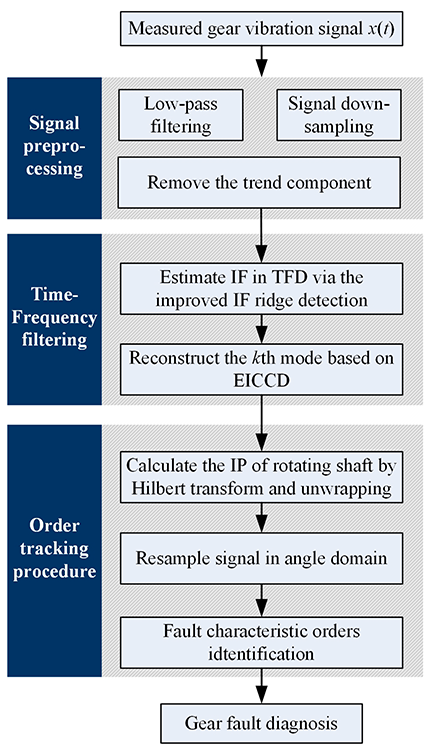 A tacholess order tracking method based on extended intrinsic chirp component decomposition for gears under large speed variation conditionsHongyang Zhao, Yuan Jiang, and Gang NiuIn Journal of Physics: Conference Series, 2022
A tacholess order tracking method based on extended intrinsic chirp component decomposition for gears under large speed variation conditionsHongyang Zhao, Yuan Jiang, and Gang NiuIn Journal of Physics: Conference Series, 2022Order tracking has been considered as the most effective non-stationary signal analysis technique for condition monitoring and fault diagnosis. Conventional order tracking is performed with a reference signal measured by the auxiliary device, which is expensive and inconvenient to install. In order to to break the constraint of the traditional order tracking technique, some tacholess order tracking methods have been developed in the past few years. However, current tacholess order tracking approaches are only applicable to slightly varying speed applications. To overcome the shortcoming above, a novel tacholess order tracking method is proposed in this paper. In the proposed method, each mode of the vibration signal is reconstructed by a method called extended intrinsic chirp component decomposition, and the Hilbert transform is used to estimate the instantaneous phase of reference shaft. Then the vibration signal is resampled to the angle domain, and the fault characteristic orders can be identified in the order spectrum accurately. The effectiveness of the proposed method has been validated by a simulated meshing gear vibration signal. The result illustrates that the proposed method can realize gears fault diagnosis under large speed variation conditions.
@inproceedings{zhao2022tacholess, title = {A tacholess order tracking method based on extended intrinsic chirp component decomposition for gears under large speed variation conditions}, author = {Zhao, Hongyang and Jiang, Yuan and Niu, Gang}, booktitle = {Journal of Physics: Conference Series}, volume = {2184}, number = {1}, pages = {012052}, year = {2022}, organization = {IOP Publishing}, doi = {10.1088/1742-6596/2184/1/012052}, }
2021
- PHM
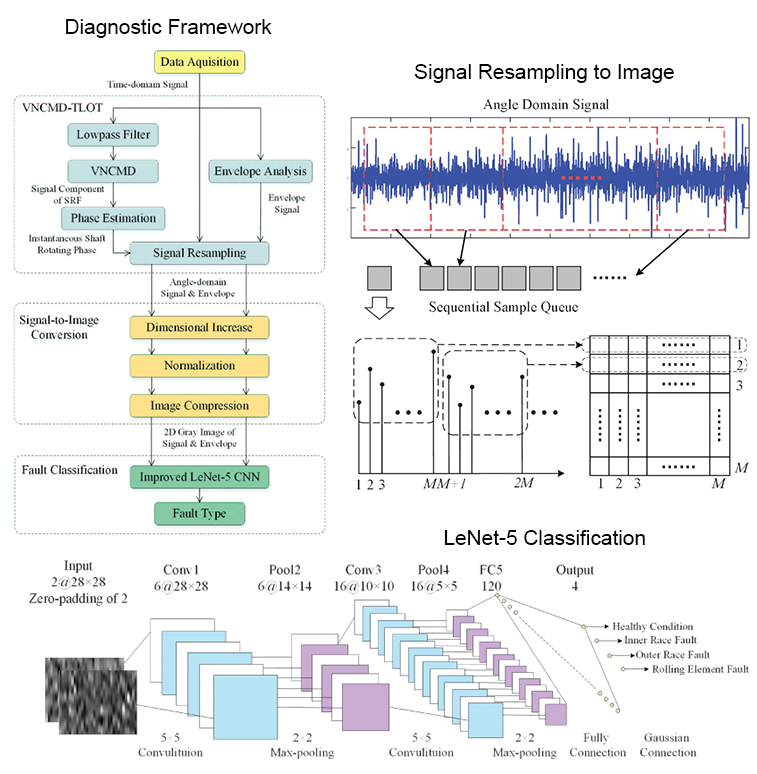 Intelligent rolling bearing fault diagnosis under variable speed conditions without tachometersYuan Jiang, Hongyang Zhao, and Gang NiuIn 2021 Global Reliability and Prognostics and Health Management (PHM-Nanjing), 2021
Intelligent rolling bearing fault diagnosis under variable speed conditions without tachometersYuan Jiang, Hongyang Zhao, and Gang NiuIn 2021 Global Reliability and Prognostics and Health Management (PHM-Nanjing), 2021Under variable speed conditions, vibration signal of rolling bearings exhibits non-stationary characteristics, which makes traditional stationary fault diagnosis methods no longer applicable. In this study, an intelligent fault diagnosis method for rolling bearings under variable speed and tacholess conditions is proposed. First, with the use of instantaneous phase of the shaft estimated by variational nonlinear chirp mode decomposition (VNCMD), the collected non-stationary time-domain vibration signals and their envelope can be resampled and transformed into stationary angle-domain signals by tacholess order tracking (TLOT). Then, one-dimensional signals are converted to two-dimensional images by dimension increase, normalization and image compression. Finally, the fault type of rolling bearings is obtained utilizing improved LeNet-5 convolutional neural network (CNN). Results on experimental data of rolling bearings under variable speed conditions demonstrate the proposed method is more effective than traditional stationary methods.
@inproceedings{jiang2021intelligent, title = {Intelligent rolling bearing fault diagnosis under variable speed conditions without tachometers}, author = {Jiang, Yuan and Zhao, Hongyang and Niu, Gang}, booktitle = {2021 Global Reliability and Prognostics and Health Management (PHM-Nanjing)}, pages = {1--7}, year = {2021}, organization = {IEEE}, doi = {10.1109/PHM-Nanjing52125.2021.9613049}, }
